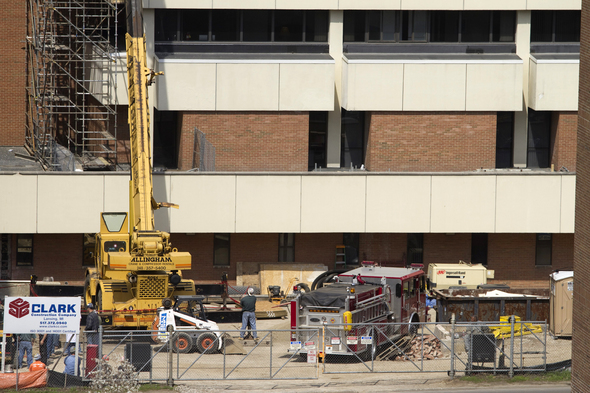Carbon monoxide: what it is, where it comes from and how to protect yourself from it

A improperly tuned skid steer loader (white vehicle, bottom left center to the left of the fire truck) similar to this one is blamed for the elevated carbon monoxide levels in Ann Arbor's city hall, according to a city news release.
Steve Pepple | AnnArbor.com
What is it, and why is it harmful?
Carbon monoxide (chemical symbol: CO) is formed when fuel burns in a relatively low oxygen environment. Clean burning fuels will react with two oxygen atoms and create carbon dioxide (chemical symbol: CO2); when there's not enough oxygen, the incomplete burning creates carbon monoxide.
When breathed by humans, carbon monoxide binds with the hemoglobin in the blood to form carboxyhemoglobin, a bright cherry red compound. Carboxyhemoglobin does not carry oxygen, and so the effect of carbon monoxide poisoning can be chemical asphyxiation. In small quantities it leads to tiredness, dizziness and unconsciousness. The half life of this compound in the body is 4 to 6 hours in normal conditions, and it can be reduced to 40 minutes by administration of pure oxygen.
Carbon monoxide as a public health risk
The federal Centers for Disease Control's Carbon Monoxide Poisoning program works with national and state data sources to monitor, evaluate and present information on carbon monoxide-related illness and death in the U.S.
One common source of carbon monoxide is the use of portable generators, especially during power outages. The CDC carbon monoxide power outage studies look at risks to the public and ways to reduce it. An interesting study looks at a 2002 North Carolina ice storm that caused 124 people to seek treatment over nine days for carbon monoxide poisoning. Of those 124 people injured, 96.2 percent of them had no working carbon monoxide detector in their house.
The National Environmental Public Health Tracking Network tracks carbon monoxide-related events. It looks at deaths, hospitalizations and poison control center calls for help. It notes that it can be hard to get good data about carbon monoxide poisoning because it's not always tracked consistently.
Carbon monoxide in ambient air
Carbon monoxide is found in the air we breathe. Mobile sources like automobile and truck exhaust are responsible for most of it. More than 48 million tons of carbon monoxide was attributed to motor vehicles in 2005 compared to just over 4 million tons from fires, according to an EPA report.
The U.S. Environmental Protection Agency monitors carbon monoxide levels with a national network of sensors looking at long term trends. The National Trends in CO Levels report from the EPA shows a steady decline in average levels, declining from a measured 9 parts per million in 1980 to 2 parts per million in 2008.
The State of Michigan monitors real time air quality through the DNRE. A network of sensors throughout the state reports hourly measurements of a number of pollutants, including carbon monoxide in some locations. The closest location I could find for real time reporting of carbon monoxide is air quality for Allen Park.
The main pollutants that are tracked on a large scale at the state level are ozone and particulates. The Detroit station sends out a Twitter message daily with forecasts; follow @MIair_Detroit for that information.
Carbon monoxide in the news
Carbon monoxide exposures occur regularly enough that you can look at news accounts of tragedies or near-tragedies every single day.
The news is full of stories; this Google News search will turn up our reporting on the Ann Arbor City Hall incident along with reports from Columbia State Community College (boiler vent knocked loose), MagnaGrow in Lawrence, Kansas (carbon monoxide buildup in molasses tank), St. Louis (propane bottle-heater in camper), and the Bronx (public school evacuation).
Protecting yourself
Carbon monoxide detectors with alarms are readily available. Consumer models cost between $40 to $70 and emit an audible alarm when elevated levels are detected. Some models combine a smoke detector with a carbon monoxide monitor.
A November 2009 Consumer Reports study (press release) notes that there is no single device on the market that detects fast burning or smoldering fires and also measures carbon monoxide, so you'll have to mix and match to get complete coverage.
I don't have specific recommendations, other than to note that CO detectors have to be replaced periodically, every five years or so. Thus that old unit that I thought was protecting my basement probably should be swapped out for a new model.
Edward Vielmetti monitors air quality for AnnArbor.com. Contact him at edwardvielmetti@annarbor.com.Â


Comments
Blue Eyes
Mon, Apr 19, 2010 : 8:49 a.m.
So has the City installed CO2 detectors on all floors of City Hall to protect employees from this happening again as construction continues?
Linda Diane Feldt
Fri, Apr 16, 2010 : 3:51 p.m.
Thanks for the article Ed. As a survivor of a carbon monoxide poisoning I am constantly bugging people to get the detectors. They weren't around when my furnace malfunctioned and nearly killed me. The problem was a clogged heat exchanged on my boiler, perhaps caused by not enough make up air for the furnace. I have an opening in the window now, to be sure there is enough air for the furnace. A head ache and flu symptoms that get better when you are outside is suspicious. Feeling sleepy when you drive is another. You can have a slow leak for months and not know it. Every house needs at least one detector. They make great presents! Along with fire extinguishers, water leak detectors (for the basement floor), and smoke alarms.